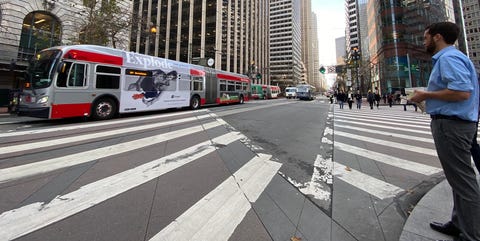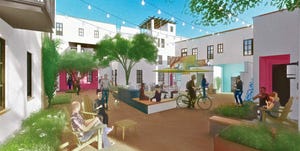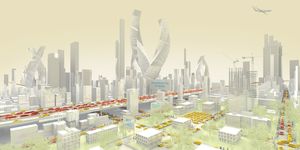
San Francisco Public Works
- On Wednesday, January 29, the city of San Francisco banned privately owned automobiles from its busy Market Street.
- This follows a move by New York City to remove cars from 14th Street in October 2019.
- In Europe’s major urban areas, car-free zones cover entire city centers and neighborhoods.
As of January 29, the 450,000 people who drive in to San Francisco each day must avoid a 1.9-mile stretch of the iconic Market Street. The city’s busiest street has gone car free, with privately owned automobiles banned to make way for pedestrians, bicyclists, taxis, and transit riders.
Jeffrey Tumlin, the director of the San Francisco Municipal Transportation Agency (SFMTA), sees a car-free Market Street bringing several benefits, all supporting his goal of safely moving the maximum number of people in the minimum amount of space. Buses will travel faster without cars getting in their way, which should attract new riders. New bike lanes are planned, which could boost another space-efficient transportation mode. Tumlin also expects that a car-free Market Street will be safer. “Half of our most deadly intersections are there,” he notes.
San Francisco’s new policy follows New York City’s decision to boot automobiles off Manhattan’s 14th Street last October, a move that proved to be so popular locals dubbed it the “Miracle on 14th Street.” These single-street experiments are small compared to car-free zones in European cities such as Amsterdam, Oslo, and Copenhagen, but they mark a significant change in the way urban planners are thinking about traffic issues. With New York and San Francisco in the lead, is a car-free wave poised to sweep across urban America roads?
Well, probably not.
The main reason is that few American streets can match the hustle and bustle of Market Street or 14th Street. A street—especially a wide one—needs lots of people on it in order to feel inviting enough to attract pedestrians and shoppers. Narrower streets, such as those common in Europe, can be comfortable with less activity, but American cities spent a fortune widening lanes for autos during the 20th century.
Except in dense urban places filled with people, removing cars from a wide street will leave it feeling deserted. People instinctively avoid lonely streets, which makes them seem even emptier. Indeed, cities like Fresno, California, and Buffalo, New York, have reintroduced cars to jump-start their struggling pedestrian malls.
That said, city transportation officials nationwide share Tumlin’s goals of moving people as efficiently and safely as possible. Rather than going straight to car-free streets, many of them are adopting less dramatic solutions such as allocating street lanes for bus rapid transit, as in Madison, Wisconsin, or banning cars from entertainment hotspots during weekends, as in Portland, Oregon.
The era of automobiles enjoying unfettered access to every lane of urban pavement is gradually ending. But kicking cars completely off an American street? Outside of a few unique places, it’s unlikely to happen.
Source: Motor - aranddriver.com




